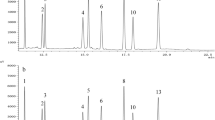Abstract
Plant carotenoids, the precursors of vitamin A display several important biological functions as antioxidants and anti-carcinogens. The oilseed crops, owing to their high oil content, form a good matrix for the bioavailability of β-carotene, thereby providing potential targets for biofortification to combat vitamin A deficiency (VAD). However, the screening and characterization of these crops, that otherwise contain very low levels of pro-vitamin A carotenoids has been difficult owing to their poor recovery and strong binding to the oil matrix. Here, we report a rapid method for high volume HPLC analysis involving the extraction and determination of β-carotene in four oilseed crops (peanut, soybean, sunflower and mustard). This included a comprehensive study of the factors that potentially influence the qualitative and quantitative yields of β-carotene in these crops. This is the first crop-independent HPLC method for the quantification of pro-vitamin A carotenoids that shows excellent recovery and reproducibility (>90 percentage recovery in oil) using small tissue sample and is capable of processing up to 30 samples per day. The protocol is sensitive, and enables better detection and separation of individual carotenoids by reducing artefacts during extraction, purification and chromatography that can be used for routine screening of oilseeds.







Similar content being viewed by others
Abbreviations
- BHT:
-
Butylated hydroxyltoluene
- DE:
-
Diethyl ether
- HPLC:
-
High-performance liquid chromatography
- PE:
-
Petrolium ether
- PDA:
-
Photodiode array detector
- PTFE:
-
Polytetrafluoroethylene
- THF:
-
Tetrahydrofuran
- VAD:
-
Vitamin A deficiency
References
Barua AB, Olson JA (1998) Reversed-phase gradient high-performance liquid chromatographic procedure for simultaneous analysis of very polar to non polar retinoids, carotenoids and tocopherols in animal and plant samples. J Chromatogr B 707:69–79
Bouis HE (2003) Micronutrient fortification of plants through plant breeding: can it improve nutrition in man at low cost? Proc Nutr Soc 62:403–411
Broszeit G, Diepenbrock F, Graf O, Hecht D, Heinze J, Martin HD, Mayer D, Schaper K, Smie A, Strehblow HH (1997) Generation, storage, and delocalization of charge in carotenoids. Liebigs Ann-Recueil 11:2205–2213
Cooper DA (2004) Carotenoids in health and disease: recent scientific evaluations, research recommendations and the consumer. J Nutr 134:221S–224S
Davey MW, Keulemans J, Swennen R (2006) Methods for the efficient quantification of fruit provitamin A contents. J Chromatogr A 1136:176–184
Graham PH, Vance CP (2003) Legumes: importance and constraints to greater utilization. Plant Physiol 131:872–877
Granado F, Olmedilla B, Gil-Martinez E, Blanco I (2001) A fast, reliable and low-cost saponification protocol for analysis of carotenoids in vegetables. J Food Compos Anal 14:479–489
Hart DJ, Scott KJ (1995) Development and evaluation of an HPLC method for the analysis of carotenoids in foods, and the measurement of the carotenoid content of vegetables and fruits commonly consumed in the UK. Food Chem 54:101–111
Humphrey JH, West KP, Sommer A (1992) Vitamin A deficiency and attributable mortality among under 5 year olds. Bull World Org 70:225–232
Kimura M, Rodriguez-Amaya DB, Godoy HT (1990) Assessment of the saponification step in the quantitative determination of carotenoids and provitamins A. Food Chem 35:187–195
Kurilich AC, Juvik JA (1999) Simultaneous quantification of carotenoids and tocopherols in corn kernel extracts by HPLC. J Liquid Chromatogr relat Technol 22:2925–2934
Patte HE, Purcell AE, Johns EB (1967) Carotenoid pigments in peanut oil. J Am Oil Chem Soc 44:328–330
Patte HE, Purcell AE, Johns EB (1969) Changes in carotenoid and oil content during maturation of peanut seeds. J Am Oil Chem Soc 46:629–631
Ping BTY, Gwendoline ECL (2006) Identification of lutein in crude palm oil and evaluation of carotenoids at various ripening stages of the oil palm fruit. J Oil Palm Res 18:189–197
Schierle J, Pietsch B, Ceresa A, Fizet C, Waysek EH (2004) Method for the determination of beta-carotene in supplements and raw materials by reversed-phase liquid chromatography: single laboratory validation. J Am Oil Chem Soc 87:1070–1082
Shewmaker CK, Sheehy JA, Daley M, Colburn S, Ke DYD (1999) Seed specific overexpression of phytoene synthase: increase in carotenoids and other metabolic effects. Plant J 20:410–412
Siong TE, Heng GA, Choo KS (1995) Carotenoid composition and content of legumes, tubers and starchy roots by HPLC. J Nutr 1:63–74
Van Lieshout M, West CE, Muhilal PD, Wang Y, Xu X, Van Breemen RB, Creemers AFL, Verhoeven MA, Lugtenburg J (2001) Bioefficacy of β-carotene dissolved in oil studied in children in Indonesia. Am J Clin Nutr 73:949–958
Weber EJ (1987) Carotenoids and tocols of corn grain determined by HPLC. J Am Oil Chem Soc 64:1129–1134
Yu B, Lydiate DJ, Young LW, Schäfer UA, Hannoufa A (2008) Enhancing the carotenoid content of Brassica napus seeds by down regulating lycopene epsilon cyclase. Transgenic Res 17:573–585
Acknowledgments
This research was supported by grants from HarvestPlus Challenge Program and the Department of Biotechnology, Government of India. We thank the Directorate of Oilseed Research, Hyderabad, India and the Peanut Breeding unit of ICRISAT for providing the seeds for this research. The technical support received from Mohd. Yousuf, D. Pandary and C. Lakshminarayana is duly acknowledged.
Author information
Authors and Affiliations
Corresponding author
Rights and permissions
About this article
Cite this article
Bhatnagar-Panwar, M., Bhatnagar-Mathur, P., Bhaaskarla, V.V. et al. Rapid, accurate and routine HPLC method for large-scale screening of pro-vitamin A carotenoids in oilseeds. J. Plant Biochem. Biotechnol. 24, 84–92 (2015). https://doi.org/10.1007/s13562-013-0239-1
Received:
Accepted:
Published:
Issue Date:
DOI: https://doi.org/10.1007/s13562-013-0239-1




